Best practices
Few periods in modern world history have been as complicated and tumultuous as the one the next U.S. administration will confront. A long list of international problems will compete for the next president’s attention upon taking office, including:
- the evolving yet persistent threat of terrorism against U.S. interests, persons, territory, and allies emanating from Islamic extremist groups like the Islamic State;
- the resurgence of an aggrieved and more aggressive Russia under Vladimir Putin, who has demonstrated his willingness to use the Russian military, an array of asymmetric tactics, and energy resources to assert his will from Ukraine to Syria;
- the rise of an increasingly powerful, capable, and confident China that appears bent on becoming the dominant power in Asia and is willing to unilaterally change the status quo and violate the rules-based international order;
- the deepening turmoil in the Middle East as four ongoing civil wars (in Syria, Libya, Yemen, and Iraq) create the most significant humanitarian crisis since the end of World War II, breathe new life into sectarian conflicts and violent extremism, and threaten to unravel established borders and destabilize neighboring regimes;
- the accelerating global proliferation of dangerous technologies, from weapons of mass destruction to sophisticated precision-guided munitions, cyber weapons and drones to both state and nonstate actors.
Equally troubling, the tools and institutions we have spent the last 70 years creating appear increasingly ill-suited to handle such challenges.

In addition to this very concrete set of challenges, the next commander in chief will have to contend with a more intangible though quite serious problem: growing uncertainty about the nature of U.S. global leadership going forward. Whether this perception is fair or unfair, it is real among many friends, competitors, and potential foes alike. The next president will therefore need to articulate a clear vision of U.S. leadership in the world and take concrete steps to demonstrate the United States’ willingness and ability to uphold its commitments and defend its interests, values and allies around the world. This will be critical to restoring credibility and confidence that America’s support for key allies and partners is iron-clad.

At the same time, the United States’ ability to cope effectively with these and other challenges is being hamstrung by the deep political divisions and paralysis in the U.S. Congress. Absent a comprehensive budget deal that lifts the draconian cuts of the Budget Control Act and the astrategic mechanism of sequestration, the next president will not be able to invest enough in the defense, diplomatic, and development tools that will be needed to protect and advance U.S. interests in a more contested and competitive global security environment. The uncertainty and disruption associated with funding the U.S. government via continuing resolutions versus regular appropriations bills has had significant costs for the key agencies involved in national security, including the Department of Defense, intelligence agencies, State Department, and USAID. Without adequate and predictable funding levels, these departments cannot plan for and invest in the capabilities critical to safeguarding U.S. national security now and in the future. The inability of the Congress to reliably provide for the common defense is creating real and accumulating risk for the United States.

In this context, no matter how determined the next American president is to focus on the domestic agenda and the compelling economic issues that were likely central to his or her electoral success, national security challenges and crises will inevitably demand no small amount of the new administration’s bandwidth, time, and energy. Rather than ignore or resist this reality, the next commander in chief would be wise to prepare for it by learning from the experiences of his or her predecessors.
Nine lessons for navigating national security in a new administration
There is much to learn from how previous presidents have managed national security issues in their first year in office. There are best practices to be emulated and mistakes to be avoided. These historical insights are complemented here by my own observations as a practitioner and participant in the national security decision-making process under two presidents and five secretaries of defense.
What follows is a list of concrete steps (in logical though not necessarily priority order) that the next president should take to better position his or her administration to handle the national security challenges and crises that will inevitably force their way onto the agenda in 2017.
1. Come into office with a clear assessment of U.S. national security challenges, opportunities, goals, and priorities, and a strategy to align the administration’s efforts in the first year.
The next president will not have the luxury of waiting until after the election is held and the official presidential transition begins. The two and a half months between Election Day and Inauguration Day are simply not enough time to do this work well. Rather, the Republican and Democratic nominees should each empower a team to begin working, even before the election, to assess the national security environment, develop a strategic framework and set of guiding principles, and articulate a clear set of priorities that will inform the administration’s early actions on national security. More specifically, each should task a senior team to draft an early version of National Security Decision Directive (NSDD) 1 that would outline in detail the governance, structure, and optempo assumptions for the national security process and deliberations. This initial work should be further refined during the transition, with the aim of having it ready to shape the administration’s earliest national security decisions and initiatives as well as its response to any crises that may arise once it is in office.
2. Choose a national security team based not only on individual experience, expertise, and qualifications for each respective cabinet position but also on how effectively the group will work as a team.
Given the wide array of challenges the United States will face, there is simply no room for learning on the job. The next president will need experienced cabinet members who are deeply knowledgeable on the issues, know how to get things done in government, understand the strengths and limits of the interagency policy-making process, and can lead and manage large institutions effectively. For national security positions at the White House, the president should make prior service in one of the national security agencies and experience participating in the interagency process a prerequisite.
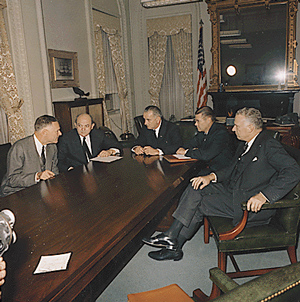
But beyond their individual attributes, the NSC principals and deputies should be chosen based on how they will work as a team. Do they share the president’s national security vision and priorities? Do they buy in to the president’s view of their role and responsibilities? Do they have the requisite skills individually and collectively to be successful in accomplishing the president’s goals?
This is not an argument for choosing a group of unquestioning loyalists. Rather, it is a case for ensuring that senior appointees who will serve on the National Security Council and on the Deputies Committee are assessed not only as individual performers but also as members of a team that will have to function extremely well in the face of unprecedented complexity and challenge.
The next president should put a premium on excellence and experience to be sure, but also on diversity, collegiality, and chemistry. In the business world, it is increasingly well understood that teams with greater diversity of perspective and experience make better decisions and create higher-performing organizations. In addition, teams comprised of people who are willing to speak up and offer their best advice and counsel, including dissent, but to do so with respect and collegiality, also perform better than those that get mired in bureaucratic turf battles and personality conflicts.
In 2008, the Obama Transition Team hung a banner in the main transition office that read: “No ego, no drama, this is not about you.” The inference was that it’s about accomplishing the mission. This adage should guide the selection of the principals (and their deputies) who will meet for countless hours in the windowless Situation Room to help the president make difficult, high-stakes decisions.
No ego, no drama, this is not about you.
3. Start with a clean sheet of paper and redesign the NSC staff and process.
Over the past two administrations, the NSC staff grew to be larger than the historical norm. In the last several years, it has also gone beyond its traditional writ of helping the president develop strategy, set policy priorities, and define the limits that should guide execution to become more engaged in managing the day-to-day details of how agencies execute national security policies and programs. The next president has a crucial opportunity both to clarify the roles and responsibilities of the national security advisor, the NSC principals, and the NSC staff and to create a more effective and efficient interagency process.
The first step is to clarify the role of the national security advisor and his or her staff vis à vis the department heads or principals who sit on the National Security Council, particularly the secretary of defense, the chairman of the Joint Chiefs of Staff, the secretary of state, and the secretary of the treasury. Historically, different presidents have relied on different models, with mixed results. Most historians and practitioners would agree, however, that one of the most effective NSC models was the Scowcroft NSC. National Security advisor Brent Scowcroft saw the role of the national security advisor and his staff as that of an honest broker, developing and assessing options for decision, ensuring the president had the benefit of the full range of perspectives when making decisions, and then, once a decision was made, providing oversight to ensure that it was executed by agencies according to presidential intent.
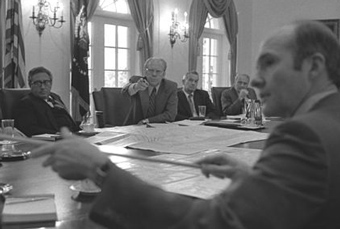
Under this model, each of the principals on the NSC was empowered to 1) participate in the development of strategy and options for the president, 2) provide their best advice and counsel to the president before he made a decision, and 3) employ the resources of their agency to execute the president’s policies within the policy parameters set by the White House. Accountability was exercised not by micro-managing agency execution from the White House but by ensuring transparency and holding principals accountable for their performance as presidentially-appointed, Senate-confirmed leaders of their respective agencies.
The next president should adopt such a model, which involves centralized policy decision and direction and largely decentralized execution. The President needs to convey to the White House staff and the cabinet that he or she intends to act more like a chief executive officer than a chief operating officer.
Accordingly, the president should direct the new national security advisor to refashion the NSC staff to be smaller, more strategic, and staffed by more senior and experienced professionals. He or she should also be explicit with each NSC principal, individually and as a team, as to expectations of their respective roles, responsibilities, decision rights, and accountabilities. The president should aim for the maximum clarity possible, recognizing that some authorities may be shared, to avoid precious time and energy being wasted on adjudicating unclear lines of responsibility over time.
The principals, in turn, should empower their subordinates to make and execute decision that are clearly within their respective lanes of responsibility.
The NSC process should emphasize transparency and accountability to enable the NSA and the President to regularly monitor progress, make course corrections as necessary, ensure interagency coordination, and hold agency heads accountable for performance. But it should take pains to avoid bringing execution decisions into the White House. Falling prey to the temptations of micromanagement only diverts senior leader attention from more strategic decisions and, ironically, draws risk to the president (as opposed to protecting him or her from it). Only a more empowered and decentralized approach to decision-making and execution will enable the next president to cope with the complexity and speed of international events and the compressed timelines for response.
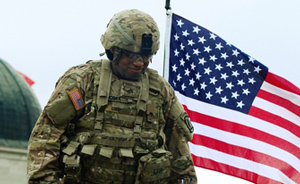
4. Pay immediate and close attention to any ongoing or imminent military or intelligence operations, particularly those that put Americans in harm’s way.
On the first day of the transition, the president should receive briefings on all ongoing military operations and intelligence activities broadly defined, as well as any diplomatic and development activities in which there is significant risk to the American personnel involved. Understanding the operational landscape he or she will inherit on January 20, 2017—including what operational authorities have been delegated below the president and even below the principals’ level—is critical to preparing to step in as Commander in Chief and avoiding being unpleasantly surprised early on. The president must know what is being done around the world in his or her name from day one. A comprehensive review of operations is a critical first step. In addition, the next president would be wise to borrow a best practice from the Bush-Obama transition and conduct a tabletop game involving both departing and incoming NSC members to familiarize the new team with existing procedures for crisis response and increase their readiness for crisis management early on.
5. Given the volume and complexity of the national security agenda, set aside time, especially early on, for a regular tempo of engagement with his or her team to set direction, monitor execution and outcomes, course correct, and learn.
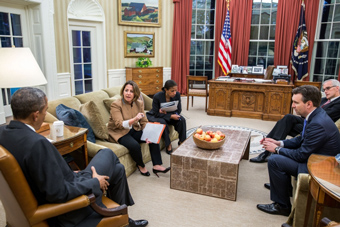
The president should protect time on the schedule not only for regular NSC meetings but also time in the Oval Office with key principals, both individually and in small groups. These more informal discussions are critical to “norming and forming” the team and to ensuring they understand presidential vision and intent when executing policy. In addition, the president should make time to engage key stakeholders—particularly anyone with critical responsibility for implementing the president’s national security priorities—in order to listen to their input and generate more buy-in and a greater sense of ownership for the new administration’s policies and initiatives. Schedule habits develop early and can be hard to change; the president should think carefully about how he or she will use different meeting venues, from the president’s Daily Brief to formal NSC meetings to more informal interactions, to engage and align the national security team and get business done.
6. Develop an initial agenda of initiatives and actions designed to signal renewed U.S. leadership internationally and communicate the administration’s strategic priorities.
The president’s strategic framework should be used to determine the priorities for U.S. diplomacy and engagement in the first months of the administration, from the initial travel schedules of key principals to the invitations sent by the White House to foreign leaders to changes made to the previous administration’s budget requests to routine military exercises and freedom of navigation operations. These and other details will be scrutinized for indications of changes in priorities and policy direction; the next President should proactively use them to send clear signals internationally.
7. Make a comprehensive budget deal a top national security priority.
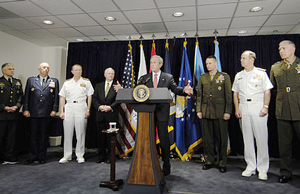
The absence of a budget deal that makes pragmatic compromises on tax reform and entitlement reform, as well as smart investments in the drivers of U.S. innovation and economic growth, has resulted in draconian cuts to discretionary spending. These cuts are undermining the diplomatic, defense, and development capabilities the United States needs to protect and advance its national security interests. This paralysis has also sent an unfortunate signal that the United States is so preoccupied internally with its own political dysfunction that it cannot be relied upon to lead the international community. In short, the absence of a comprehensive budget deal has become a national security issue—one that the next President must address urgently with the new Congress.
8. Ensure that the national security team invests in a healthy civil-military relationship.
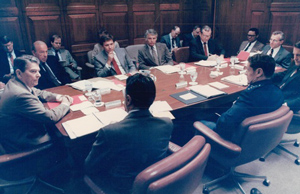
Most Presidents, and many on the national security team, come into office without any military experience or even any experience working with the military. In some cases, they may have no clear concept for how civil-military relations should work; in other cases, they may arrive with misconceptions about how their military counterparts think and behave. Similarly, on the military side, senior officers may come to the table with unrealistic expectations about how the civil-military relationship is supposed to work (too often based on theories taught in war colleges that may have little grounding in reality). This state of affairs sets up both parties for frustration and disappointment. Given the centrality of the national security agenda, and the criticality of getting use of force decisions right, the next President should invest in training civilian appointees on how to work effectively with the military; by the same token, senior military officers should be included in the efforts to norm and form the new national security team, as described above.
9. Invest in the people on the national security team, whether political appointees, civil servants, foreign service officers, intelligence professionals, or military officers.
One of the sure-fire ways to increase a team’s performance is to invest in its human capital—the recruitment, training, professional development, and retention of its people. Yet in government, taking care of one’s people is too often seen as ancillary or even irrelevant to the main mission and practically impossible given the frenetic pace and long hours. The next President should impress on his or her direct reports the importance of a “stewardship mindset” and the need to take a different approach.
More specifically, the President should start by having the transition team develop a human capital strategy before coming into office. The next President should also increase the resources available to the Presidential Personnel Office and the White House Personnel Office to ensure that world-class practices are used to find, recruit and vet in a timely manner the best talent for appointed positions. The President should make clear to the national security advisor and NSC principals that each of them is expected to invest in the training, professional development, and mentoring of their staffs and to adopt best practices in human capital management
Conclusion
Many of the national security challenges the next President will confront may be unavoidable. But, if history is any guide, there are a number of steps that he or she can take to better prepare and position the new administration to deal with these challenges and exploit opportunities more effectively. These recommendations are certainly no panacea. But they can help a new President start strong as commander in chief, reduce the risk of major national security missteps in the first year of a new administration, and substantially improve the President’s chances of being able to advance a smart international agenda and ultimately strengthen both U.S. national security and U.S. global leadership.